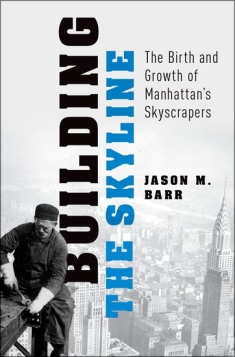RU-N Professor Writes Book to Tell the Story behind Manhattan’s Skyline
Many consider Manhattan to be one of the most fascinating places on Earth. People travel from all over the world to see its amazing sights. Perhaps most indelible of all its features, however, is its skyline.
While many historians have tackled the architectural, political, and geographical history of Manhattan’s skyline, few have explored the economic and real estate history that made it the great wonder it is today. Jason Barr, Rutgers University-Newark economist and associate professor, sat down to discuss how his book, Building the Skyline: The Birth and Growth of Manhattan’s Skyscrapers (Oxford University Press, 2016), enlightens the reader about New York’s intriguing history.
What is Building the Skyline: The Birth and Growth of Manhattan’s Skyscrapers about?
The book chronicles the economic history of Manhattan. It explores Manhattan’s natural, geological, and real estate history, and how they impacted the skyline in the 20th century. It also documents the real estate decisions made by the early Dutch and English settlers and discusses the many aspects of the history of skyscrapers, including the reasons for their heights and locations on the island.
What inspired you to write the book? 
Building the Skyline contains the findings of my research over the last decade on New York City skyscrapers and real estate. As an economist, I have an interest in urban economics. After discovering that few economists were writing about the economic history of the city or skyscrapers, I felt it was important to record my findings in a book to introduce my research to a larger audience beyond just economists. As a person whose family history is rooted in New York City, I had a personal interest in learning more about the city and my family.
Can you briefly describe your writing process?
I started with an outline for the book based on the several journal articles I had published over the years. I then conducted more research about New York City’s history to fill in much of the context as well as missing elements from my academic work. Once I had a vision of how the book would flow, I sat down and wrote it, chapter by chapter, with a general audience in mind. The writing process took more than two years.
Given the challenges of writing for a general audience, how does your book capture the interest of someone who is not an economist?
I tried my best to write the book from a historical perspective as interpreted by an economist – weaving together a narrative history of Manhattan. That’s why I felt it important to begin at the literal beginning with Manhattan’s natural and geological history and move forward from there, so I could give readers the larger context in which the skyline was created. I believe this approach offers a new way of thinking about the city’s history. The challenge, as an economist, was to balance the historical discussion with talking about some of the mathematical and statistical models I’ve written about in the academic articles.
What are your favorite parts of the book?
Each chapter serves a specific purpose, but I found dispelling what I call the “bedrock myth” as well as describing the reasons for the birth of midtown to be the most exciting aspects to research and write about. Throughout the book, as a result of my investigations, I was able to disprove several misunderstandings concerning Manhattan’s skyscrapers. For example, many experts argue the Manhattan skyline consists of downtown and uptown due to the depth of Manhattan’s bedrock. This idea is false; midtown emerged as a result of the demographic and economic forces at play after the Civil War. It has been my goal to set the record straight.
“A skyscraper is a machine that makes the land pay” – Cass Gilbert. Does your book support or negate this statement? Is there any correlation between your economic views and those of prominent architect, Cass Gilbert?
I make a few references to Cass Gilbert in the book and, by and large, I agree with this statement. When land values are high, the only way for developers to be compensated for the cost is to build taller or larger buildings so they can generate more revenue. However, I also argue in my book, that we shouldn’t focus solely on the developer’s side of the story to inform our understanding of the location or size of skyscrapers. The reasons why particular areas are valued more than others also need to be considered. High prices suggest that the residents are eager to be in those area and will pay for the right to be there. By constructing taller buildings, developers are satisfying the demand for people to work, live, and play in the city. Without these tall buildings, people would have to go elsewhere. While I agree with Gilbert’s statement, I would say that from an economist’s perspective, a skyscraper is a machine that allows people to earn a livelihood.
Why do you think the information provided in your book is important to share?
Although a lot has already been written about New York City, I think my book offers readers a new perspective. Hardly anything has been written about the economic incentives that drive skyscraper construction across the city. Given how crucial these buildings are for the well-being of cities and the people who live and work in them, I think I bring a fresh and interesting perspective about something so important to our lives.
Photo of Jason Barr by Kathy O'Connor
Book cover image by Lewis Hine (1930), courtesy of the National Achive


